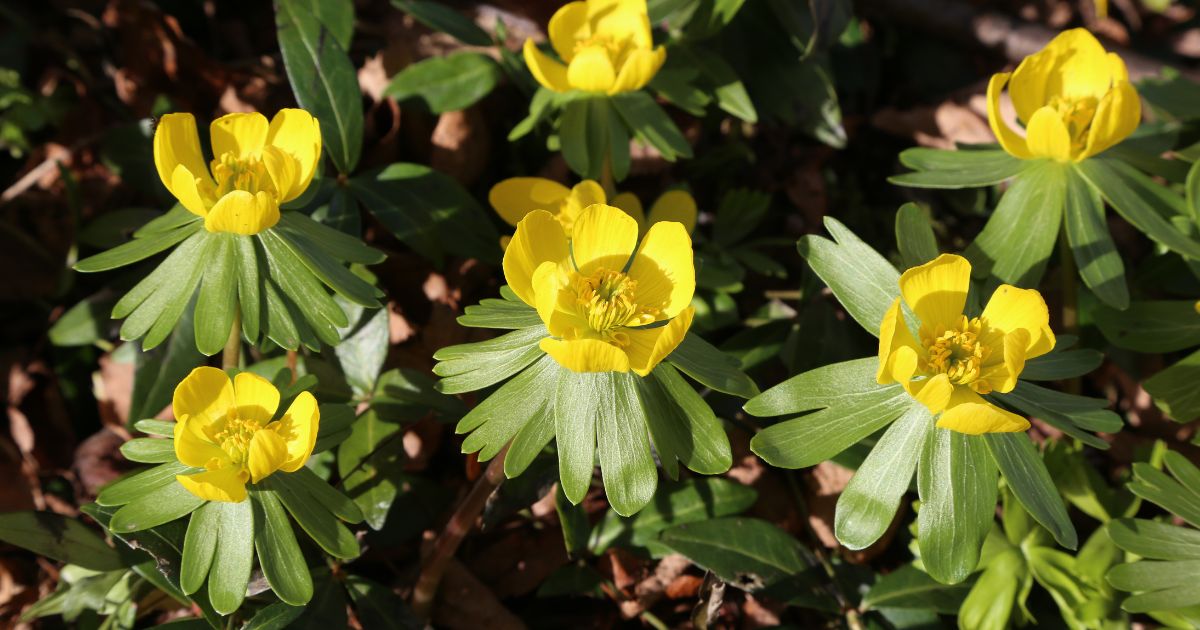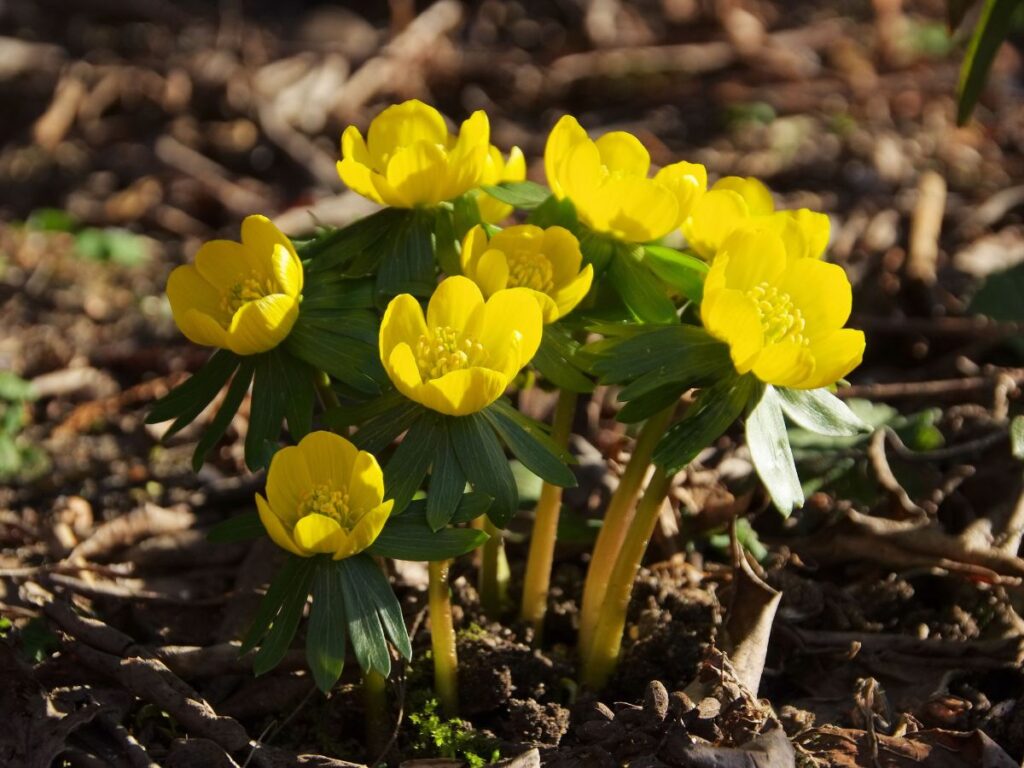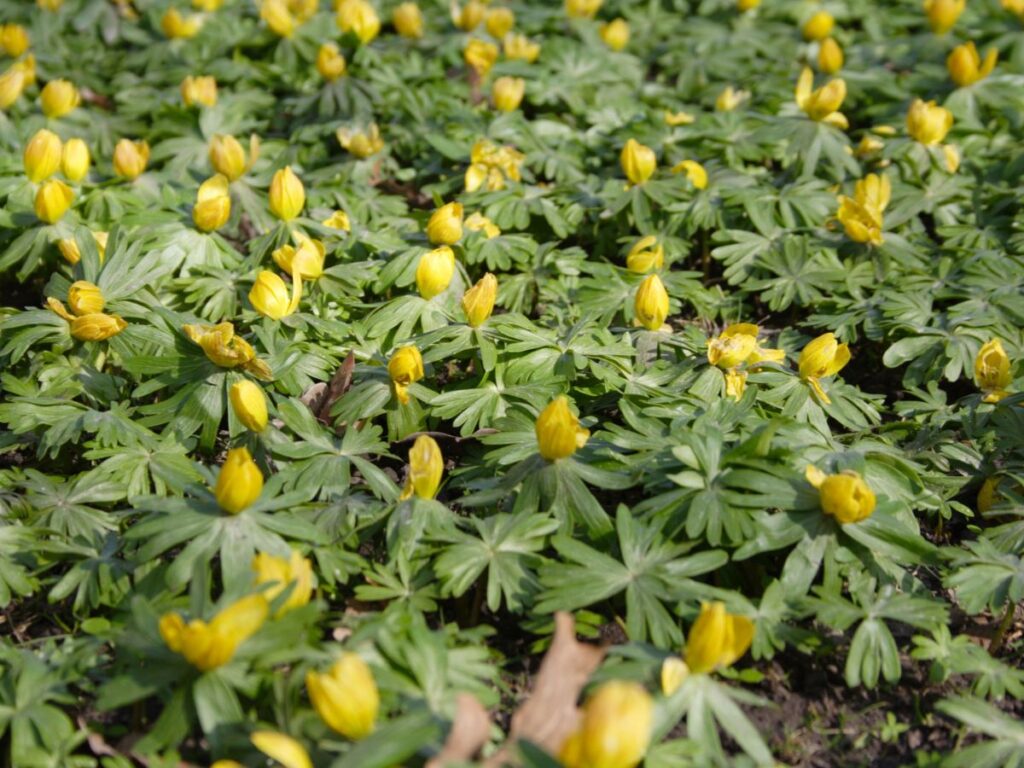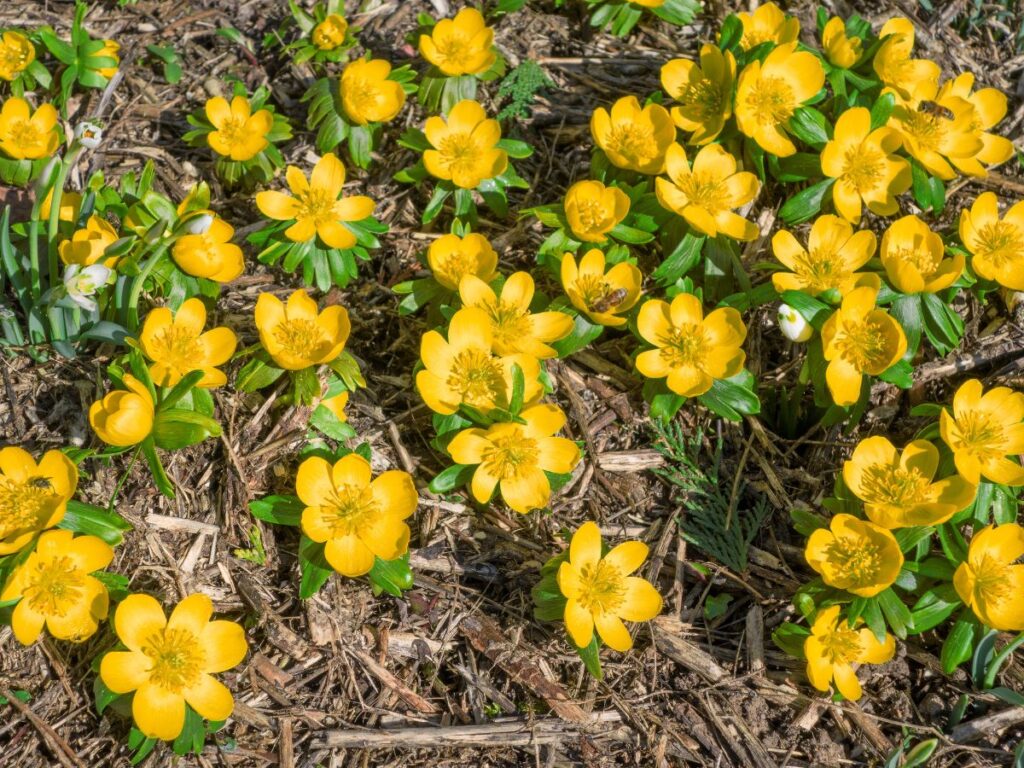Winter aconites bring a burst of sunshine to your garden during those chilly months when other plants are taking a break. To grow winter aconites, plant the tubers in early autumn in a well-draining soil enriched with organic matter.
Choose a spot with partial shade, as these little wonders thrive under deciduous trees and shrubs, where they can create a stunning yellow carpet.
You will need to ensure that the soil remains moist but not waterlogged. Too much water can lead to rot, so good drainage is key. Adding a layer of mulch can help retain moisture and protect the tubers from harsh winter conditions.
Once established, winter aconites multiply easily, granting you a vibrant display that grows more impressive each year. Their ability to naturalize makes them a great choice for creating low-maintenance, yet delightful, winter displays in your garden.
Getting to Know Winter Aconites
Winter aconites brighten up gloomy winters with their vibrant yellow flowers. Native to Southern Europe, these charming plants thrive in cold climates, offering a delightful splash of color in late winter and early spring.
Understanding their origin and needs will help you nurture them successfully.
Origin and Characteristics
Winter aconites, known scientifically as Eranthis hyemalis, originate from woodland areas in Southern Europe. These perennial plants belong to the buttercup family.
They are recognized for their small golden-yellow flowers, which bloom early in the year, often peeking through the snow. Each flower is surrounded by a collar of greenish bracts, resembling a delicate skirt.
These plants are compact, usually growing to about 3-4 inches tall. The foliage is lush, forming a pretty carpet once the flowers fade. Their growth habit makes them ideal for naturalizing in gardens, rockeries, and woodland settings.
Winter aconites are not only charming but also resilient, making them a favorite among gardeners looking for early spring color.
Preferred Climate and Conditions
Winter aconites thrive in regions with cold winters and mild summers. They prefer well-drained soil rich in organic matter.
Moisture is crucial, especially during their active growing phase in late winter and early spring. Ensure the soil doesn’t dry out during this period, as it could affect blooming.
These plants love dappled shade. Plant them beneath deciduous trees or shrubs where they can enjoy sunlight before the trees fully leaf out.
Full sun is also tolerated but keep in mind they may require more moisture. When planting, mix in compost to improve soil fertility, boosting growth and bloom.
Planting Essentials
For successful growth of winter aconites, consider the location and soil. Choosing the right spot and ensuring good soil conditions will give these bright yellow flowers the best start.
Choosing the Right Location
Winter aconites thrive best in locations that replicate their natural wooded habitat. Look for a spot under deciduous trees or shrubs, where they can enjoy the dappled sunlight in early spring.
Avoid full sun, as this can dry out the soil too quickly. A partially shaded area provides the right balance, offering protection from harsh temperatures and winds.
This placement also helps the bulbs store energy before summer dormancy. Ideal temperatures are cool but not freezing, ensuring the plants don’t get scorched by excessive heat.
Keep in mind that proper drainage is crucial as these plants don’t tolerate waterlogged roots.
Soil Preparation
Winter aconites prefer organically rich and well-drained soil. Test the soil’s pH and aim for neutral to slightly alkaline levels for optimal growth.
You can easily amend soil by adding well-rotted leaf mold or aged compost. These will improve soil consistency and provide necessary nutrients.
Before planting, use a garden fork or tiller to loosen the soil to a depth of about 6 inches. Remove any weeds, rocks, or debris.
Ensure good drainage by incorporating grit or sand if needed. Creating a healthy soil environment will allow the bulbs to establish strong root systems and flourish throughout the growing season.
Caring for Your Winter Aconites
Proper care ensures that your winter aconites thrive, showcasing vibrant blooms and rich foliage. Focus on watering correctly, fertilizing wisely, and maintaining a healthy environment through mulching and weed control.
Watering Techniques
Winter aconites enjoy moist soil, so regular watering is key, especially in dry spells. Over-watering can harm them, so ensure the soil is well-drained.
Light, frequent watering is often more beneficial than deep soaking, especially in clay-heavy areas. When the leaves start dying back, reduce watering as the roots need less moisture.
Use a watering can with a sprinkle head to avoid disturbing the soil. Monitoring rainfall helps you adjust your schedule. Naturally, snow provides moisture, and melted snow acts as an ideal water source.
Observe your aconites; their foliage serves as an indicator of water needs. Wilted leaves might mean it’s time for a drink.
Fertilizing and Feeding
Winter aconites are low-maintenance but benefit from nutrient-rich soil. Use a balanced, slow-release fertilizer at planting time and once more at the blooming stage. This encourages stronger growth and enhanced flowering.
Organic options like compost or well-rotted manure provide ample nutrients while improving soil quality.
Apply fertilizer in moderation and avoid direct contact with roots, as this could cause damage. Nutrient-rich soil means less reliance on additional feeding sessions.
Remember, less is often more when it comes to fertilizing. Overfeeding can lead to excessive foliage at the cost of flowers.
Mulching and Weed Control
Mulching around your winter aconites offers numerous benefits: it retains moisture, suppresses weeds, and improves soil quality. Use a 2 to 3-inch layer of organic mulch, like shredded leaves or bark.
This protective layer helps regulate soil temperature, beneficial in fluctuating spring conditions.
Regularly check for weeds intermingling with the aconites. Weeds compete for water and nutrients and harbor pests. Gentle removal is essential to avoid disturbing the shallow roots of the aconites.
In addition, weed shears can be helpful for precise removal without uprooting surrounding plants. Take care to maintain a neat environment to promote healthy blooming.
Propagation Methods
When propagating winter aconites, you have two main methods to consider: division and seed sowing. Both techniques have their unique processes and benefits.
Division
Division is a straightforward and efficient method for propagating winter aconites. You should do this in early spring, right after the flowers have faded but before the foliage dies back completely.
Gently lift the clump of plants from the ground using a garden fork. Be careful not to damage the roots as you do so. Or you can use your hands.
Then, carefully separate the individual tubers. Make sure each tuber has roots attached. Replant the divided tubers immediately to prevent them from drying out.
Ensure they are planted at the same depth they were growing before, about two to three inches deep. Water the new plantings well to help them establish. Remember, some tubers might take a year or two to produce blooms, so patience is key.
Seed Sowing
Seed sowing requires more patience but can be rewarding. You should collect seeds in early summer when the seed pods begin to open. Plant the seeds as soon as possible, ideally in a seed tray filled with moist compost.
Cover the seeds with a very thin layer of compost or sand. Winter aconite seeds need a period of cold stratification, so place the seed tray outside in a sheltered spot, exposed to winter conditions. This process mimics natural conditions and helps in germination.
Keep the soil moist but not waterlogged throughout winter. Germination usually occurs in spring, but it may take a year for seedlings to sprout. Once the seedlings have grown for a full season, you can transplant them to their permanent location in your garden.
Pest and Disease Management
Winter aconites are quite resilient, but they aren’t immune to pests or diseases. Keeping an eye on your plants will help catch issues early.
Common Pests:
- Slugs and Snails: These critters love moisture, just like winter aconites. Use barriers, like crushed eggshells, to deter them.
- Aphids: Look out for these on leaves. A gentle spray of soapy water can get rid of them effectively.
Diseases to Watch For:
- Gray Mold (Botrytis): Can appear in damp conditions. Ensure good air circulation and remove affected leaves.
- Bulb Rot: It’s often due to waterlogged soil. Improve drainage to prevent this issue.
Take some time to inspect your plants regularly. You’ll want to check leaves, stems, and the base. If you notice any unusual discoloration or damage, it might be time to take action.
Preventative Measures:
- Keep the garden area tidy and free from debris.
- Encourage beneficial insects like ladybugs that eat harmful pests.
- Use a balanced fertilizer to keep plants healthy and stress-resistant.
Don’t hesitate to ask local garden centers for advice on products that can help manage these issues. Each garden is unique, so what works for one may not work for another. Stay vigilant, and your winter aconites will thrive!
Enjoying the Blossoms
Winter aconites bring a cheerful, golden display to your garden. You can enhance this beauty by cutting and arranging them for indoor enjoyment, creating delightful floral arrangements with these vibrant blossoms.
Cutting and Arranging
When cutting winter aconites, do so in the early morning when the plants are hydrated. Use sharp scissors or pruning shears to ensure a clean cut. It’s best to choose stems with half-open flowers for longevity. Place the cut flowers immediately in a clean container with water.
Arranging Tips:
- Use small vases or jars, as aconites are petite.
- Combine with other early spring flowers like snowdrops or crocuses.
- Change the water daily to keep them fresh longer.
These simple steps allow you to bring a little outdoor sunshine indoors during the chill of winter.
Growing winter aconites is more than a horticultural exercise; it’s an affirmation of life’s persistence. In a world that often emphasizes speed and immediate results, the winter aconite stands as a quiet counterpoint.
It reminds us that sometimes the most remarkable things happen not when conditions are perfect, but when they are challenging. By planting winter aconites, you become part of this enduring story, one where beauty and resilience go hand in hand.














